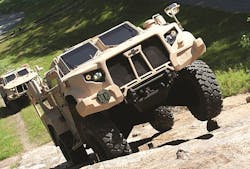Army for JLTV armored combat vehicles continues to roll-in with order for 611 more
WARREN, Mich. –Armored combat vehicles experts at Oshkosh Defense LLC in Oshkosh, Wis., are building another 611 new Joint Light Tactical Vehicle (JLTV) systems and vetronics under terms of a $177.6 million order announced on 31 Aug.
Officials of the U.S. Army Contracting Command in Warren, Mich., are asking Oshkosh to build the 611 new JLTVs, as well as 1,789 installed and packaged kits. It is the sixth order for JLTVs since the contract was awarded in August 2015, Oshkosh officials say.
This is the second large JLTV order within a month's time. On 31 July the Army ordered 748 new JLTVs and 2,359 installed and packaged JLTV kits in a $195.5 million contract modification -- the fifth order since the original JLTV contract.
This latest order is a modification to a $114.7 million contract to Oshkosh in August 2015 for JLTV low-rate initial production (LRIP) and full-rate production. That contract has options that eventually could increase its value to $6.7 billion, and is expected to be one of the most lucrative military vehicle programs over the next decade.
The Oshkosh JLTV is a version of the company's Light Combat Tactical All-Terrain Vehicle (L-ATV). The JLTV program was delayed shortly after the initial contract was awarded by a protest by Oshkosh rival Lockheed Martin Corp. The program resumed in February 2016 after Lockheed Martin's protest was dismissed.
The U.S. Department of Defense (DOD) wants to buy 54,599 JLTVs -- 49,099 for the U.S. Army and 5,500 for the U.S. Marine Corps. The U.S. Government Accountability Office (GAO) estimates that the DOD will spend more than $53.3 billion on the JLTV program -- $1.1 billion for research and at least $52.3 billion for procurement.
The Oshkosh JLTV is a light utility and combat multi-role vehicle that is expected to deliver a level of protection similar to that of current, but far heavier and less maneuverable, Mine Resistant Ambush Protected (MRAP) class designs, and much better than the latest armored Humvees.
The JLTV has two variants -- a two seat and a four seat variant, as well as a companion trailer (JLTV-T). The Oshkosh vehicle offers the Core1080 crew protection for survivability, turret operated systems, remote weapons systems, and tube-launched missile system.
The Oshkosh JLTV features the company's TAK-4i intelligent independent suspension system that adjusts ride-height type with as much as 20 inches of wheel travel. The vehicle also has the digitally controlled General Motors Duramax V8 cylinder 6.6-liter diesel engine.
Related: Army takes another shot at developing modern armored combat vehicle after numerous setbacks
The vehicle can be fitted with light, medium, and heavy machine guns, automatic grenade launchers, smoke grenade launchers, or anti-tank missiles, operated from ring mounts or a remote weapon station.
The original JLTV contract, awarded on behalf of the Army Tank-automotive and Armaments Command (TACOM) in Warren, Mich., has eight options for Oshkosh to build the first 16,901 vehicles for the Army and Marine Corps.
On the latest order Oshkosh will do the work in Oshkosh, Wis., and should be finished by August 2024. For more information contact Oshkosh Defense online at https://oshkoshdefense.com, the Army Contracting Command-Warren at http://acc.army.mil/contractingcenters/acc-wrn, or Army TACOM at www.tacom.army.mil.
Ready to make a purchase? Search the Military & Aerospace Electronics Buyer's Guide for companies, new products, press releases, and videos

